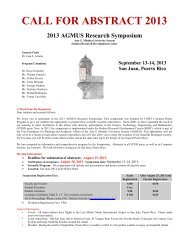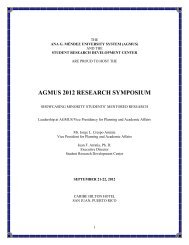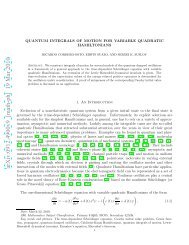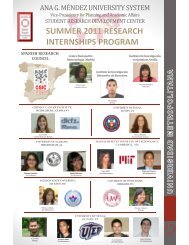WINTER 2008 PRE-COLLEGE RESEARCH SYMPOSIUM - Student ...
WINTER 2008 PRE-COLLEGE RESEARCH SYMPOSIUM - Student ...
WINTER 2008 PRE-COLLEGE RESEARCH SYMPOSIUM - Student ...
You also want an ePaper? Increase the reach of your titles
YUMPU automatically turns print PDFs into web optimized ePapers that Google loves.
COMPUTATIONAL CHEMISTRY/BIOASTRONOMY<br />
COMPUTATIONAL STUDY SODIUM CYANIDE-NACN FOUND IN THE EGG<br />
NEBULA<br />
Amanda M. Rolón, Bautista de Puerto Nuevo Academy, San Juan, Puerto Rico.<br />
Research Mentors: Dr. Juan F. Arratia, Executive Director, <strong>Student</strong> Research Development<br />
Center, Ana G. Méndez University System, San Juan, Puerto Rico; Dr. José Cernicharo,<br />
Department of Astrophysics, Astrobiology Center, Spanish Research Council (CSIC), Madrid,<br />
Spain.<br />
<strong>Student</strong> Research Mentor: Germán P. Castillo, Universidad Metropolitana, San Juan, Puerto Rico.<br />
The purpose of this project was to learn about the existence of NaCN in space and to create a 3-D<br />
model of sodium cyanide – NaCN using software Gaussview to later use these models in the<br />
computational chemistry software Gaussian 03 to be able to calculate energetic and the optimized<br />
state of the molecule. The calculations were based upon the difference in temperature and<br />
pressure between Earth and the Egg Nebula. Sodium Cyanide was detected by B. E. Turner, T. C.<br />
Steimle, and L. Meerts in the Egg Nebula. The Egg nebula is a bipolar proto-planetary nebula<br />
characterized by its series of bright arcs and circles surrounding the central star. Sodium Cyanide<br />
is an inorganic highly toxic salt and is used mainly in gold mining. From the outcome of the<br />
research and simulation a relationship was established between temperature and the energies. The<br />
zero point energy remains constant unaffected by temperature or pressure. The enthalpy and<br />
energy showed an inversely proportional behavior to temperature, and Gibbs free energy behaved<br />
directly proportional to temperature. During this investigation basic concepts of chemistry were<br />
learned by the group to understand how to correctly model a molecule based on its formula.<br />
COMPUTATIONAL STUDY OF SODIUM CYANIDE – H 2 CNH FOUND IN<br />
SAGGITARIUS B2<br />
Jann R. López, Nuestra Señora de la Altagracia School, San Juan, Puerto Rico.<br />
Research Mentors: Dr. Juan F. Arratia, Executive Director, <strong>Student</strong> Research Development<br />
Center, Ana G. Méndez University System, San Juan, Puerto Rico; Dr. José Cernicharo,<br />
Department of Astrophysics, Astrobiology Center, Spanish Research Council (CSIC), Madrid,<br />
Spain.<br />
<strong>Student</strong> Research Mentor: Germán Castillo, Universidad Metropolitana, San Juan, Puerto Rico.<br />
Sodium Cyanide also known as methanimine was first detected by P. D. Godfrey, R. D. Brown,<br />
among others in the molecular cloud called Sagittarius B-2. Sagittarius B-2 is a dense Hll region<br />
and the richest concentration of molecules located near the center of the Milky Way Galaxy. The<br />
molecule methanimine H 2 CNH can react with hydrogen and then water to form glycine, a simple<br />
amino acid. The second objective of the project was to develop a 3-D model of the molecule in<br />
the software Gaussview with the purpose to use it in computational chemistry calculations using<br />
the software Gaussian 03, to find its most stable state and the energies. The calculations were<br />
done using the different temperatures and pressure of Earth and Sagitarius B-2. These<br />
calculations resulted in a difference in the energetics for the molecule in the different areas such<br />
as zero point energy, and the enthalpy. In this investigation several tutorials about Gaussian 03<br />
and Gaussview were provided to understand the procedure.<br />
26








